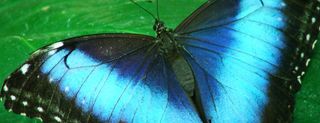Butterflies Inspire Anti-Counterfeit Technology

(ISNS) -- A Canadian company is fighting counterfeiters by employing one of the most sophisticated structures in nature: a butterfly wing.
To be precise, Nanotech Security Corp. in Vancouver is using the natural structure of the wings of a Morpho butterfly, a South American insect famous for its bright, iridescent blue or green wings, to create a visual image that would be practically impossible to counterfeit. The technology was developed at British Columbia’s Simon Fraser University, and licensed to the company.
The phenomenon Nanotech employs is similar to the way some animals, including male peacocks, produce iridescent colors: instead of using proteins and other chemicals to produce a hue, the creature’s feathers or scales play with light, using very tiny holes that reflect different colors or wavelengths. The Morpho does this with complicated scales on its wing that produce shimmering blues and greens.
Nanotech’s printed security image can be embossed on virtually any surface, including plastics, metals, solar cells, fabrics, and paper, according to Clint Landrock, Nanotech’s chief technical officer. They even could be embedded on pills and capsules to ensure they are genuine pharmaceuticals, instead of fakes.
“It lends itself to anything your imagination can come up with,” he said, “even brake pads.”
The work is another example of what scientists call biomimicry, which adapts nature’s solutions for innovative human devices, in this instance, nano-optics, a burgeoning new technology.
Researchers at the University of Michigan, for example, use nano-optics to print pictures and images without ink or dyes.
Sign up for the Live Science daily newsletter now
Get the world’s most fascinating discoveries delivered straight to your inbox.
Landrock, one of the inventors, said the Simon Fraser researchers actually studied the shingled, patterned plates of a Morpho wing to see how it handled incoming light. The trick was to make artificial “nano-hole arrays,” which produce similar iridescent efforts with simpler structures. That way, the company can mass-produce billions of nano-holes.
“We can tune the colors by changing the geometry of those hole arrays,” he said.
They used a method similar to the manufacturing of computer chips, known as electron beam lithography, to produce master nano-hole patterns embossed on silicon or quartz.
They worked at the scale of nanometers. A single nanometer is hundreds of times smaller than even the tiniest bacterial cell. The holes in the template ranged from 50 to 300 nanometers in diameter, spaced 300-600 nanometers apart. The process takes from a few hours to a couple of days to produce a master pattern, or mask, depending on the size of the mask and the number of structures. After the mastering, a second process grows the image on nickel. From there it can be transferred to any material.
The entire image could be large enough to be seen from a distance, and, if embossed on high-priced items like designer handbags, would make it easy to spot the phonies, said Doug Blakeway, Nanotech’s CEO.
“If you had a hand bag and the clasp on it had the company’s logo on it you would see it and it would turn on and off in very bright colors.” Simply moving the item or the observer would make the color flicker.
There shouldn’t be any issue with putting the image on a capsule or pill, he said. You could see the brand on it to be sure the medicine was authentic. It would not require Food and Drug Administration approval because the image would not involve dyes or pigments so medicine would not be altered in any way.
Counterfeiting this technology is unlikely, Landrock said. The image would be very difficult to reverse engineer, and expensive because of the equipment needed. The image is much brighter than any created by any other technology, he explained, including holograms.
“I like to say it is similar to describing how an old CRT television display looks compared to a new Ultra HD LED TV,” he said “They may be showing the same thing but you would never mistake one for the other.”
Landrock said the most logical use for the technology would be an anti-counterfeiting device on bank notes.
A nano-optics image can be embossed on coated paper, but many countries, including Canada and Australia, have switched to polymer plastics for its bank notes, which are even more receptive to nano-optics images. Those bills last much longer than U.S. paper currency and are much harder to counterfeit.
Since the company has only begun commercializing the technology, no country has yet signed up.
Even so, it is unlikely the U.S. dollar will see nano-optics any time soon. U.S. bank notes do not even use holograms, common in other currencies, or coated or polymer paper, according to Darlene Anderson, a spokeswoman for the U.S. Bureau of Engraving and Printing.
The reason for the conservative bills, is that most American currency is held overseas, where it is often used as the reserve currency for the undeveloped world, said Owen Linzmayer, publisher of Banknote News, an industry observer. A radical change to U.S. bills could upset international economies and flood the country with the old bills.
The same restraints do not apply for Gucci handbags.
Joel Shurkin is a freelance writer based in Baltimore. He is the author of nine books on science and the history of science, and has taught science journalism at Stanford University, UC Santa Cruz and the University of Alaska Fairbanks.
Inside Science News Service is supported by the American Institute of Physics.
